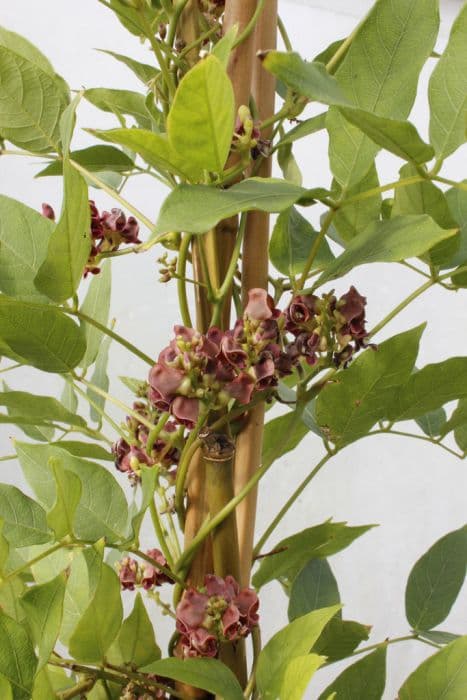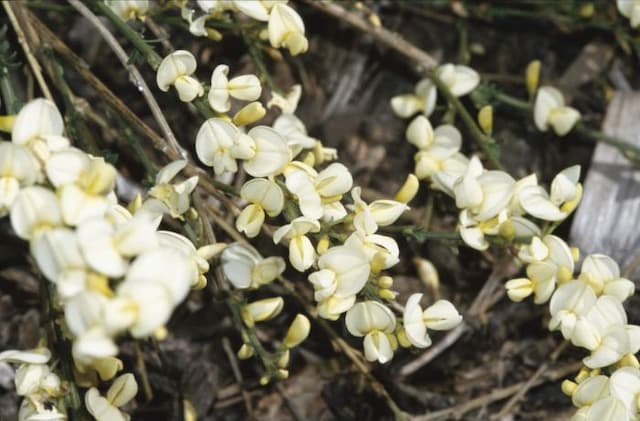Goat's rue 'Lady Wilson' Galega × hartlandii 'Lady Wilson'

ABOUT
Goat's Rue or French Lilac, specifically the 'Lady Wilson' variety, is an ornamental plant known for its attractive foliage and flowers. It has bright green, pinnate leaves that are slender and pointed. During its blooming phase, it produces clusters of small, pea-like flowers, typically lavender or pale blue in color. These flowers form in racemes and provide a colorful display that adds a delicate and airy feel to the plant's overall appearance. The plant is often admired for its charming and prolific flowering, making it a popular choice in gardens.
About this plant
 Names
NamesFamily
Fabaceae
Synonyms
Goat's Rue, French Lilac
Common names
Galega officinalis 'Lady Wilson'
 Toxicity
ToxicityTo humans
Goat's Rue or French Lilac, including the 'Lady Wilson' variety, is known to be toxic to humans. The plant contains galegine and other potentially harmful compounds. If ingested, it can cause symptoms such as nausea, vomiting, diarrhea, and more severe effects like hypoglycemia in large quantities. It is essential to exercise caution and avoid ingesting any part of this plant.
To pets
Goat's Rue or French Lilac is also toxic to pets, including dogs and cats. Ingestion can lead to similar symptoms as in humans, such as gastrointestinal upset, vomiting, and diarrhea. In some cases, more severe symptoms could occur depending on the amount ingested. Pet owners should ensure that their animals do not have access to this plant. If ingestion occurs, it is advisable to seek immediate veterinary care.
 Characteristics
CharacteristicsLife cycle
Perennials
Foliage type
Deciduous
Color of leaves
Green
Flower color
Lavender
Height
3 feet 36 inches (91 centimeters)
Spread
2 feet 24 inches (60 centimeters)
Plant type
Herb
Hardiness zones
2
Native area
Europe
Benefits
 General Benefits
General Benefits- Aesthetic Value - Goat's Rue adds beauty to gardens with its delicate lavender flowers and lush green foliage.
- Attracts Pollinators - The flowers attract bees and butterflies, supporting local pollinator populations.
- Nitrogen Fixation - As a member of the Fabaceae family, it helps in fixing nitrogen in the soil, improving soil fertility.
- Erosion Control - Its root system can help stabilize soil and control erosion, particularly in sloped areas.
- Wildlife Habitat - Provides a habitat for various small wildlife and insects, enhancing biodiversity in the garden.
- Privacy Screen - When planted in groups, it can serve as a natural privacy screen in gardens or along borders.
 Medical Properties
Medical PropertiesThis plant is not used for medical purposes.
 Air-purifying Qualities
Air-purifying QualitiesThis plant is not specifically known for air purifying qualities
 Other Uses
Other Uses- Garden Borders - Goat's Rue is often used to create vibrant borders in gardens due to its attractive foliage and flowers.
- Cottage Gardens - It fits well in cottage garden designs, adding a rustic and charming element with its lush growth and lavender flowers.
- Bee Gardens - The plant is excellent for bee gardens as it attracts and supports bee populations.
- Butterfly Gardens - Its flowers are also attractive to butterflies, making it a suitable choice for butterfly gardens.
Interesting Facts
 Feng Shui
Feng ShuiThe Goat's Rue is not used in Feng Shui practice.
 Zodiac Sign Compitability
Zodiac Sign CompitabilityThe Goat's Rue is not used in astrology practice.
 Plant Symbolism
Plant Symbolism- Resilience - Goat's Rue symbolizes resilience and the ability to thrive in various conditions, reflecting its hardy nature.
- Attraction - Its ability to attract bees and butterflies can be seen as a symbol of attraction and magnetism in the natural world.
- Protection - The dense growth of Goat's Rue can symbolize protection and shelter, providing a safe space for wildlife.
 Water
WaterGoat's Rue should be watered regularly, especially during dry spells. Aim to keep the soil consistently moist but not waterlogged. During the growing season, water approximately 1 gallon per week per plant, adjusting for rainfall. In hotter, drier climates, more frequent watering may be necessary. Reduce watering in the winter when the plant is dormant. Over-watering can lead to root rot, so ensure good drainage in the soil.
 Light
LightGoat's Rue thrives in full sun to partial shade. It prefers at least 6 hours of sunlight per day for optimal growth and flowering. In very hot climates, some afternoon shade can help protect the plant from scorching. The ideal spot would be one that receives morning sunlight and some protection during the hottest part of the day.
 Temperature
TemperatureGoat's Rue does well in a wide range of temperatures but prefers temperate conditions. It can tolerate minimum temperatures down to around 20°F. The ideal temperature range for growth is between 60°F and 75°F. Extreme heat or cold can stress the plant, so consider its placement in the garden accordingly.
 Pruning
PruningPrune Goat's Rue in late winter or early spring to remove dead or damaged stems and to maintain its shape. Pruning after flowering can encourage a second bloom. Regular pruning helps to rejuvenate the plant and encourages more vigorous growth.
 Cleaning
CleaningAs needed
 Soil
SoilGoat's Rue prefers well-draining, fertile soil with a pH of 6.0 to 7.0. A mix of garden soil, compost, and some sand or perlite is ideal for ensuring good drainage and adequate nutrition. The soil should be enriched with organic matter to support healthy growth. It's important to avoid overly wet or waterlogged conditions to prevent root rot.
 Repotting
RepottingGoat's Rue, when grown in containers, should be repotted every 2-3 years to refresh the soil and accommodate root growth. The best time to repot is in the early spring, just before the growing season begins. Choose a pot that is slightly larger than the current one and ensure it has adequate drainage holes.
 Humidity & Misting
Humidity & MistingGoat's Rue is adaptable to a range of humidity levels and does not require specific humidity conditions. It thrives in the average outdoor humidity and does not necessitate adjustments when grown in a typical garden setting.
 Suitable locations
Suitable locationsIndoor
Ensure bright light, well-draining soil, water regularly but avoid overwatering.
Outdoor
Plant in full sun to partial shade, in well-draining soil, water moderately.
Hardiness zone
4-8 USDA
 Life cycle
Life cycleGoat's Rue begins its life cycle as a seed, which germinates in favorable conditions of moisture and temperature. The seedling stage is characterized by the emergence of the first leaves and a primary root system. As the plant matures, it develops a more robust root system and fuller foliage, with bright green, pinnate leaves. The plant reaches maturity when it starts to produce its characteristic lavender flowers, typically in the summer months. After the flowering period, the plant sets seeds, which can be dispersed to give rise to new plants. During the winter months, the plant may die back, especially in colder climates, before regenerating in the spring.
 Propogation
PropogationPropogation time
Early spring
The most common method of propagating Goat's Rue is through seed sowing. The best time for this is in early spring when the soil begins to warm up. The seeds should be sown in well-draining soil and lightly covered with soil or compost. They require consistent moisture to germinate effectively, which usually takes a few weeks. Once the seedlings have developed their first set of true leaves, they can be transplanted to their final location. This method is straightforward and effective, allowing for the easy cultivation of new plants while maintaining the genetic diversity of the species.
 Pests
PestsAphid, Slugs and snails
 Diseases
DiseasesRoot Rot, Powdery mildew, Rust









